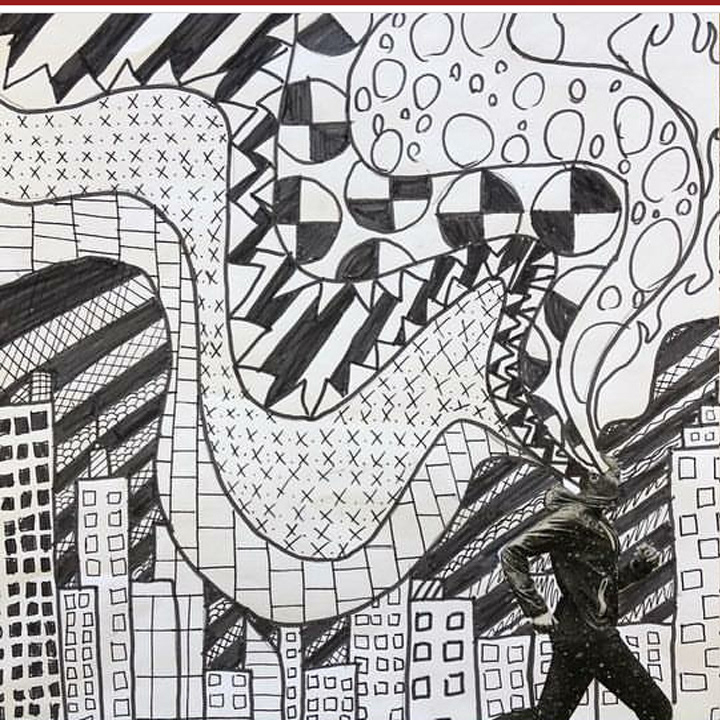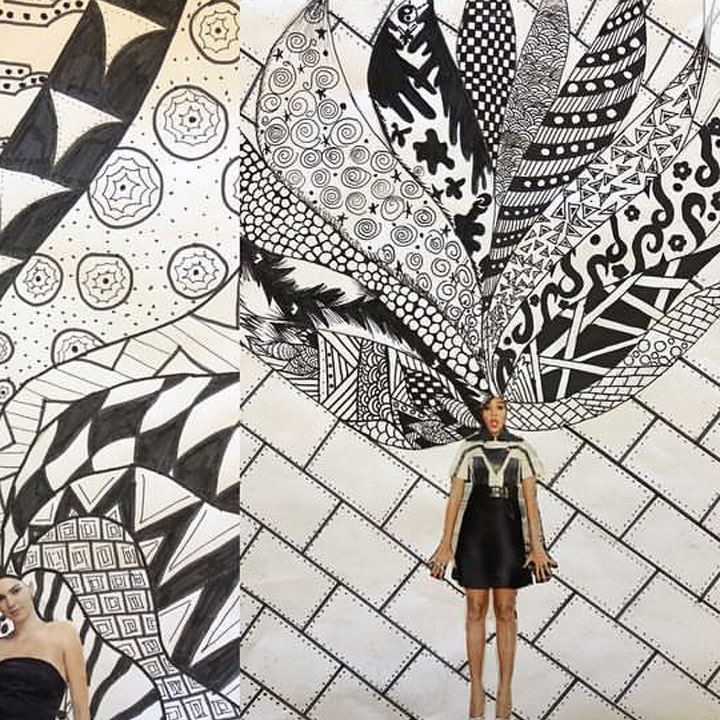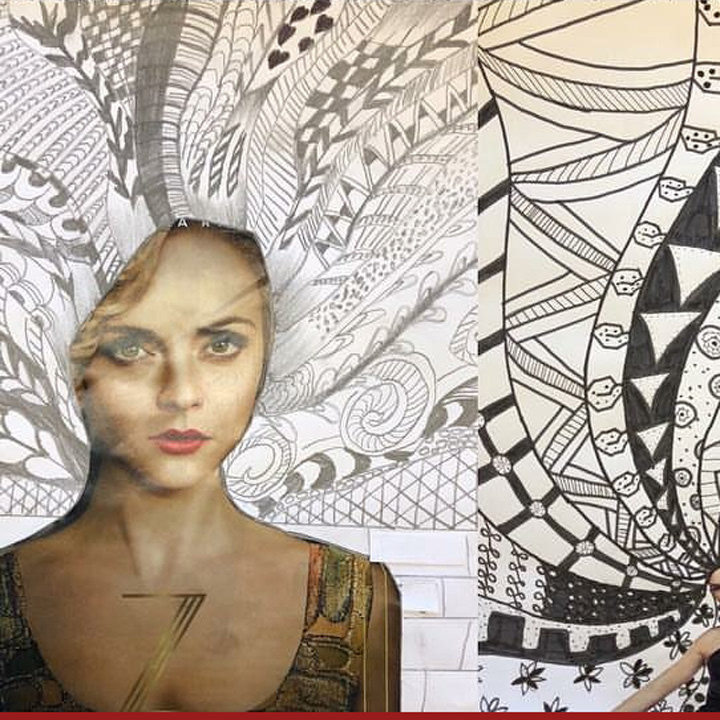About the Zentangle Method
Through the Zentangle Method of drawing, you can:
Relax
Focus
Expand your imagination
Trust your creativity
Increase your awareness
Respond confidently to the unexpected
Discover the fun and healing in creative expression
And most importantly . . . Have fun!
STAGE 1 – DESIRED RESULTS
A: Enduring Understandings
Students will understand that:
• Zentangles are a unique drawing process in which a string is a defining
line or shape that becomes hidden in an organized mess of shapes called a
tangle.
• Art can be a meditative process and artists often pause to reflect on their
work.
• Accidents or mistakes made in a piece of art can be made to look
intentional.
A: Enduring Understandings
Students will understand that:
• Zentangles are a unique drawing process in which a string is a defining
line or shape that becomes hidden in an organized mess of shapes called a
tangle.
• Art can be a meditative process and artists often pause to reflect on their
work.
• Accidents or mistakes made in a piece of art can be made to look
intentional.
B: Essential Questions
• What makes a Zentangle different from a pattern?
• How can art be a meditative process?
• How can you turn a mistake into a happy accident?
• How can making art build confidence?
C: Standards/Frameworks: (MA)
1. Methods, Materials, and Techniques. Students will demonstrate knowledge of the
methods, materials, and techniques unique to the visual arts.
2. Elements and Principles of Design. Students will demonstrate knowledge of the
elements and principles of design.
3. Observation, Abstraction, Invention, and Expression. Students will demonstrate
their powers of observation, abstraction, invention, and expression in a variety of
media, materials, and techniques.
4. Drafting, Revising, and Exhibiting. Students will demonstrate knowledge of the
• What makes a Zentangle different from a pattern?
• How can art be a meditative process?
• How can you turn a mistake into a happy accident?
• How can making art build confidence?
C: Standards/Frameworks: (MA)
1. Methods, Materials, and Techniques. Students will demonstrate knowledge of the
methods, materials, and techniques unique to the visual arts.
2. Elements and Principles of Design. Students will demonstrate knowledge of the
elements and principles of design.
3. Observation, Abstraction, Invention, and Expression. Students will demonstrate
their powers of observation, abstraction, invention, and expression in a variety of
media, materials, and techniques.
4. Drafting, Revising, and Exhibiting. Students will demonstrate knowledge of the
processes of creating and exhibiting their own artwork: drafts, critique, self-
assessment, refinement, and exhibit preparation.
assessment, refinement, and exhibit preparation.
5. Critical Response. Students will describe and analyze their own work and the work
of others using appropriate visual arts vocabulary. When appropriate, students will
connect their analysis to interpretation and evaluation.
D: Acquisition/Learning Objectives: •Students will know what a Zentangle is and what its similarities and
differences are compared to regular drawings and patterns. •Students will learn how to analyze and be reflective about their own
artwork. •Students will be skilled at using black thin and thick Sharpie markers
to create a balance of blacks, whites, and patterns that read as gray, as well
as when they will make thick or thin lines.
of others using appropriate visual arts vocabulary. When appropriate, students will
connect their analysis to interpretation and evaluation.
D: Acquisition/Learning Objectives: •Students will know what a Zentangle is and what its similarities and
differences are compared to regular drawings and patterns. •Students will learn how to analyze and be reflective about their own
artwork. •Students will be skilled at using black thin and thick Sharpie markers
to create a balance of blacks, whites, and patterns that read as gray, as well
as when they will make thick or thin lines.
STAGE 2 – ASSESSMENT EVIDENCE
A: Performance Tasks as Evidence:
A: Performance Tasks as Evidence:
• The final work will be an individualized Zentangle (6”x6”) that
demonstrates a balance between blacks, whites, and patterns, overall
neatness, and an engaging composition that guides the viewer around
the page.
B: Other Evidence/ Continuum of Assessments:
• Each student will have a one-on-one conference with the teacher to
reflect on the choices they made in their artwork.
• The teacher will ask the student what their favorite part of their
Zentangle is as well as which part of the drawing was the most
challenging for them.
• Students will also be assessed on the use of originality and creativity in
their designs.
demonstrates a balance between blacks, whites, and patterns, overall
neatness, and an engaging composition that guides the viewer around
the page.
B: Other Evidence/ Continuum of Assessments:
• Each student will have a one-on-one conference with the teacher to
reflect on the choices they made in their artwork.
• The teacher will ask the student what their favorite part of their
Zentangle is as well as which part of the drawing was the most
challenging for them.
• Students will also be assessed on the use of originality and creativity in
their designs.
STAGE 3 – LEARNING PLAN
A: Materials and equipment:
• Pencils
• Erasers
• Black Sharpies, thick and thin
• Paper (6”x6”)
• Rulers (optional)
A: Materials and equipment:
• Pencils
• Erasers
• Black Sharpies, thick and thin
• Paper (6”x6”)
• Rulers (optional)
D: Instruction:
DAY ONE:
• Teacher will have students explore the concept of Zentangles by having
a class discussion in which students break down the meaning of each part of
the word.
• Teacher will walk students through the first steps of setting up their
drawing with a demonstration up on the board.
• Teacher will have students watch each step first before trying it on their
own papers.
• Teacher will explain to students that the these first steps of the project
will be done in pencil, not Sharpie.
• Teacher will begin by drawing a thin border around the edge of their
page.
DAY ONE:
• Teacher will have students explore the concept of Zentangles by having
a class discussion in which students break down the meaning of each part of
the word.
• Teacher will walk students through the first steps of setting up their
drawing with a demonstration up on the board.
• Teacher will have students watch each step first before trying it on their
own papers.
• Teacher will explain to students that the these first steps of the project
will be done in pencil, not Sharpie.
• Teacher will begin by drawing a thin border around the edge of their
page.
• Teacher will ask the class for an idea of their defining line or string and
add the suggestion to their example page.
• Teacher will demonstrate air drawing to the class by air drawing the
chosen string.
• Teacher will ask for the first shape that should be added to that tangle.
• Teacher will allow students to begin adding shapes to hide their defining
line or string.
DAY TWO:
• Teacher will emphasize the idea of ‘having a conversation with your
artwork.’
• Teacher will have students find a compliment about their work and an
area they would like to change or keep working on.
• Teacher will ask students about the concept of a Zentangle to generate
class discussion.
• Teacher will show a brief PowerPoint presentation that shows images of
four Zentangles.
• Teacher will have students point out the defining line or string of each
Zentangle example.
• Teacher will explain that students should begin to use Sharpie to create
their Zentangle if they are feeling confident about their design plan.
• Teacher will have students continue to work on their Zentangles.
• Teacher will have one-on-one check-ins with each student.
DAY THREE:
• Teacher will have students explain the steps of how to make a
Zentangle.
• Teacher will introduce the idea of incorporating a balance between
blacks, whites, and patterns that read as gray.
• Teacher will show the same PowerPoint slide of the four Zentangles.
• Teacher will ask students which color their eye is drawn to first, black or
white?
• Teacher will point out the blacks, whites, and grays in each Zentangle
example.
• Teacher will explain that patterns closer together read as a darker gray
and patterns farther apart read as a lighter gray.
• Teacher will emphasize the importance of having a balance between
lights and darks.
• Teacher will have students continue to work on their Zentangles.
• Teacher will have one-on-one check-ins with each student.
DAY FOUR:
• Teacher will prompt students to question what makes a Zentangle
unique from regular drawings or patterns.
• Teacher will have students find a compliment about their work and an
area they would like to change or keep working on.
add the suggestion to their example page.
• Teacher will demonstrate air drawing to the class by air drawing the
chosen string.
• Teacher will ask for the first shape that should be added to that tangle.
• Teacher will allow students to begin adding shapes to hide their defining
line or string.
DAY TWO:
• Teacher will emphasize the idea of ‘having a conversation with your
artwork.’
• Teacher will have students find a compliment about their work and an
area they would like to change or keep working on.
• Teacher will ask students about the concept of a Zentangle to generate
class discussion.
• Teacher will show a brief PowerPoint presentation that shows images of
four Zentangles.
• Teacher will have students point out the defining line or string of each
Zentangle example.
• Teacher will explain that students should begin to use Sharpie to create
their Zentangle if they are feeling confident about their design plan.
• Teacher will have students continue to work on their Zentangles.
• Teacher will have one-on-one check-ins with each student.
DAY THREE:
• Teacher will have students explain the steps of how to make a
Zentangle.
• Teacher will introduce the idea of incorporating a balance between
blacks, whites, and patterns that read as gray.
• Teacher will show the same PowerPoint slide of the four Zentangles.
• Teacher will ask students which color their eye is drawn to first, black or
white?
• Teacher will point out the blacks, whites, and grays in each Zentangle
example.
• Teacher will explain that patterns closer together read as a darker gray
and patterns farther apart read as a lighter gray.
• Teacher will emphasize the importance of having a balance between
lights and darks.
• Teacher will have students continue to work on their Zentangles.
• Teacher will have one-on-one check-ins with each student.
DAY FOUR:
• Teacher will prompt students to question what makes a Zentangle
unique from regular drawings or patterns.
• Teacher will have students find a compliment about their work and an
area they would like to change or keep working on.
• Teacher will have students continue to work on their Zentangles.
• Teacher will have one-on-one check-ins with each student.
DAY FIVE:
• Teacher will ask students how they know if they’re done with their
Zentangle.
• Teacher will review the idea of blacks, whites, and grays, well planned
compositions, and overall neatness.
• Teacher will have students continue to work on their Zentangles.
• Teacher will have one-on-one conferences with each student who thinks
they are done.
• Teacher will continue to check-in with every student.
• Teacher will have one-on-one check-ins with each student.
DAY FIVE:
• Teacher will ask students how they know if they’re done with their
Zentangle.
• Teacher will review the idea of blacks, whites, and grays, well planned
compositions, and overall neatness.
• Teacher will have students continue to work on their Zentangles.
• Teacher will have one-on-one conferences with each student who thinks
they are done.
• Teacher will continue to check-in with every student.



